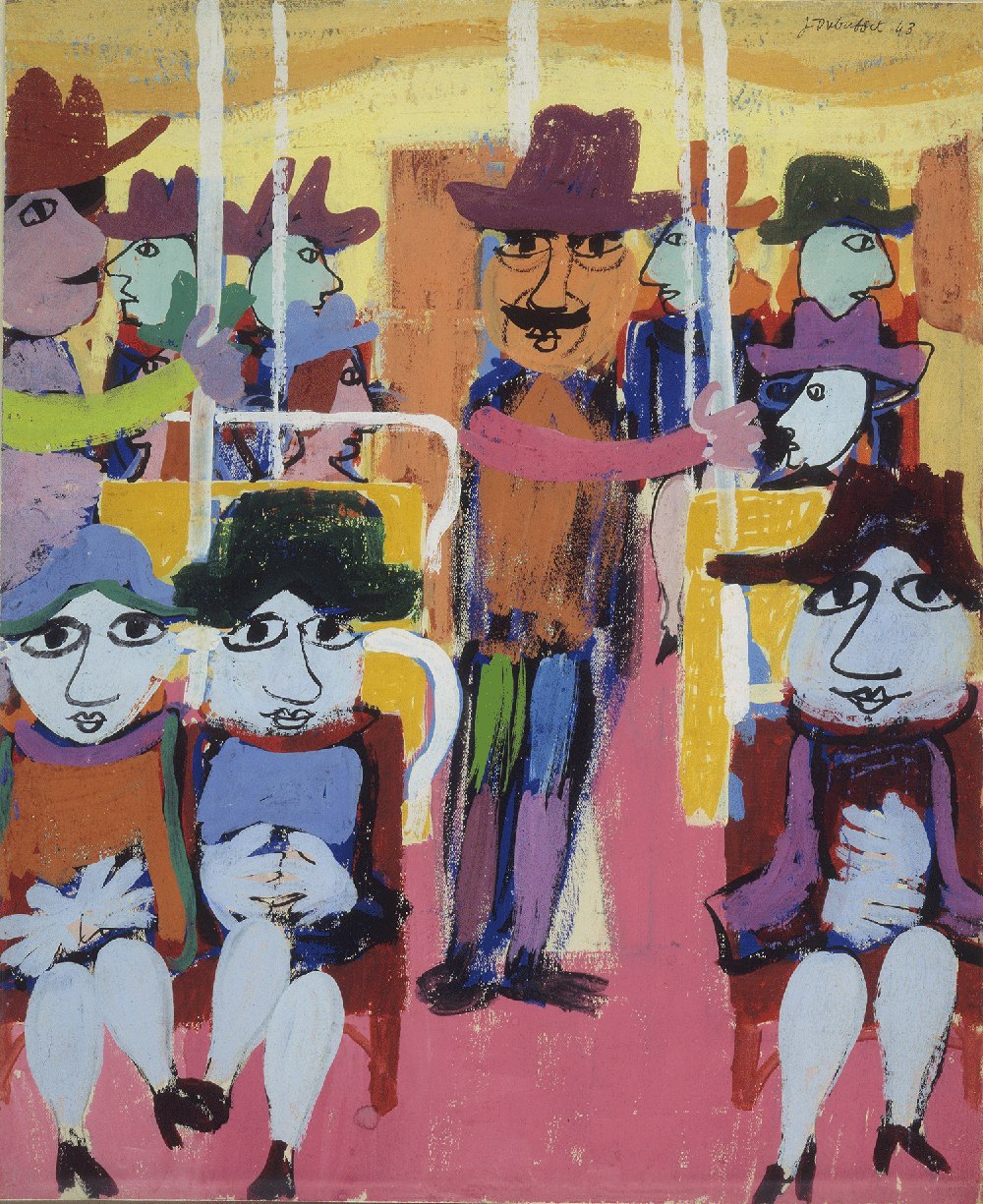BEYOND THE 805

Jean Dubuffet, Le Métro, March 1943. Gouache. 14½ × 12 in. (36.8 × 30.5 cm).
Centre national d’art et de culture Georges Pompidou, Paris.
Musee national d’art moderne / Centre de creation industrielle.
Photography by Philippe Migeat.
© 2016 Artists Rights Society (ARS), New York / ADAGP, Paris.
Art Review
Jean Dubuffet Drawings at the Hammer
Jean Dubuffet Drawings at the Hammer
The current exhibition of Jean Dubuffet’s drawings at UCLA’s Hammer Museum is the first exhibition of Dubuffet’s drawings of this depth and scope. Consisting of almost 100 works created between 1935 and 1962 it spans Dubuffet’s most creative years, curated by Isabelle Dervaux, Acquavella Curator of Modern and Contemporary Drawings at the Morgan Library and Museum. The Hammer presentation is curated by Connie Butler, chief curator, with Emily Gonzalez-Jarrett, curatorial assistant. Dubuffet is in some ways the most influential and perhaps best French artists since WW II , so this show represents an important addition to the understanding of his work and post-war art history scholarship.
Dubuffet is well known for being influenced by children’s art, the art of psychiatric patients and graffiti, especially that of earlier ages, even Roman era samples, long before the invention of aerosol paint cans.
Usually the discussion of Dubuffet’s sources and inspiration has been left at that. This show of drawings suggests that that may have been a mistake. If drawing is how painters think, then these drawings show a lot about how Dubuffet thought and it shows new insight into his work that may not be accessible by an examination of his paintings alone.
Dubuffet is essentially self-taught, so his development does not follow the arc of a formally trained painter. Many painters spend their early years drawing to develop specific compositional ideas and their ability to record specific spatial and graphic relationships, often with an early development of their ability to render the world around them with increasing accuracy. Even many great abstract painters--from Matisse to Picasso to DeKooning--spend early years honing their observational skills, often with nude models, photographic source materials, or direct observation of nature. Even if self-taught, there have been many such naive painters who spend some time trying to reproduce the world around them in their drawing.
Dubuffet seems to waste little time with any of that. His drawings focus immediately on specific problems that are necessary for the realization of his paintings, independent of nature or any direct observation. There is something a bit odd about Dubuffet’s drawings. Very early on there is an almost obsessive interest in making marks that pile up to produce densely textured fields. There are drawings that are difficult to tell what, if anything, Dubuffet “was drawing”. In other drawings, he deploys his naively drawn linear figures against these scribbled fields, sometimes attempting to mimic more painterly effects. And there is another thing: most modern painters make drawings that are usually much smaller than the resulting paintings; many of Dubuffet’s drawings are almost as large as Dubuffet’s finished paintings from the same period.
Yet what a spectator of this show does not see, since there are no paintings in it, is that the paintings that come out of the drawings in this show are notable for being highly unified in terms of the treatment of paint across their surfaces, yet they exploit the knowledge Dubuffet gains in his drawings rendering one type of figure drawing against a very different type of textural background. Throughout this show we see in his drawings a struggle to unify two different types of marking that we do not see in the resulting paintings, that in fact will appear highly unified in his paintings of the same period. In other words, the struggle we see in the drawings is solved in his paintings; or to put it the other way around, looking only at his paintings, we would have far less insight into the struggle that went on behind them, in the drawings leading up to them.
The problem here, of course, is that there are no Dubuffet paintings in this show for visitors to compare or see how startling this is. Nevertheless, the exhibition is fully accessible and enjoyable on its own.
One of the things many visitors will notice is how playful Dubuffet is, even when being a bit uncanny, or attempting to disturb. What comes through is a sense of playfulness. This is perhaps why many authors have claimed Dubuffet’s influence from children’s drawings. I would hope this show raises some questions regarding that as well. I’m not sure children draw this way. It is a conceit and perhaps a wary subterfuge to create room for his relatively raw and naive draughtsmanship. Dubuffet exhibits far too much sophistication and interest in technical issues along with formal problems that would not interest most children. These drawings reveal, as never before, just how conscious and deliberate this exploration is and how much effort Dubuffet put into his search for a highly unified and coherent painterly style during these three decades.
Dubuffet Drawings 1935 - 1962
organized by the Morgan Library and Museum, New York. Exhibition curated by Isabelle Dervaux, Acquavella Curator of Modern and Contemporary Drawings at the Morgan Library and Museum. The Hammer Musuem presentation is curated by Connie Butler, chief curator, with Emily Gonzalez-Jarrett, curatorial assistant
organized by the Morgan Library and Museum, New York. Exhibition curated by Isabelle Dervaux, Acquavella Curator of Modern and Contemporary Drawings at the Morgan Library and Museum. The Hammer Musuem presentation is curated by Connie Butler, chief curator, with Emily Gonzalez-Jarrett, curatorial assistant
at the Hammer Museum
10899 Wiltsire Boulevard, Los Angeles
Museum hours: Tues-Fri 11 am - 8 pm; Sat-Sun 11 am - 5 pm
Closed Mondays and national holidays
Admission free to all public exhibitions
10899 Wiltsire Boulevard, Los Angeles
Museum hours: Tues-Fri 11 am - 8 pm; Sat-Sun 11 am - 5 pm
Closed Mondays and national holidays
Admission free to all public exhibitions
Through 30 April 2017
_____________________

